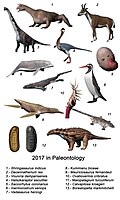
Photo from wikipedia
The nature of the Cretaceous–Paleogene (K/Pg) boundary in the Kurdistan region of northeastern Iraq is still under debate. Most studies have considered the Danian sediments to be mostly missing. Another… Click to show full abstract
The nature of the Cretaceous–Paleogene (K/Pg) boundary in the Kurdistan region of northeastern Iraq is still under debate. Most studies have considered the Danian sediments to be mostly missing. Another hypothesis suggests that a conglomerate represents the contact between the Cretaceous and Paleogene. We examined the succession of the Deramazan and Chinarok sections in Sulaimani area to examine calcareous nannofossil assemblages and the biostratigraphy around the boundary and the Danian sediments; previously, the calcareous nannofossil has not been applied to this sequence. The rock strata in the study sections are characterized by alternations of sandstone, siltstone, shale and marlstone within the Tanjero Formation (late Campanian–Maastrichtian) and the overlying Kolosh Formation (Paleocene–early Eocene). The current study shows that deposition across the boundary in both sections was continuous with no discernible break or pause in sedimentation; it is biostratigraphically delineated by the first occurrences of Biantholithus sparsus, Cruciplacolithus spp. and Coccolithus pelagicus plus an acme of Thoracosphaera operculata of biozone NP1 that indicates no hiatus. The successions in both sections also highlight the occurrence of the early Danian sequence at the bottom of the Kolosh Formation.
Journal Title: Carbonates and Evaporites
Year Published: 2020
Link to full text (if available)
Share on Social Media: Sign Up to like & get
recommendations!